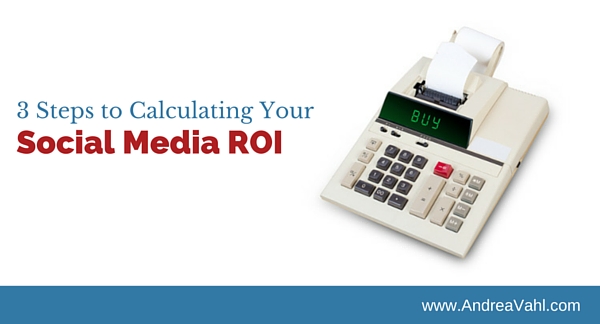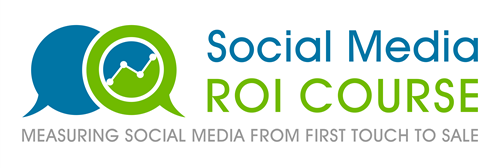How do you know your social media marketing efforts are working? And what does “working” mean to you?
The problem with calculating the return on investment of social media is that it’s a money-based equation.
Some of the value of the work you are doing is intangible.
What is the value of the relationships you are building and forming?
But just because calculating the return is more complex, doesn’t mean that you shouldn’t try to quantify your return and track it at all.
You may add more weight to the intangible benefits later but by putting a tracking system in place, you’ll be able to make more strategic decisions about what types of tactics work best for you in your future campaigns.
The Return on Investment Equation
ROI is a measure of profit for each investment or marketing campaign. You may have made more sales from a particular campaign, but it may have cost you more to execute that campaign. So it’s important to “normalize” your results so that you can easily see which campaigns or tactics were better profit centers for you.
First let’s start with the ROI Equation. It’s deceptively simple.
When you calculate your ROI you are going to get a ratio (or you may want to look at it as a percentage)
So for example – let’s say you had Sales of $5000 for a launch of a product and we’ll just keep this example simple (I’ll unpack the details a little later):
Sales = $5000
Investment:
Facebook Ads cost – $350
Work by assistant – $75
Work by you – 5 hours ($100/hour) = $500
Total investment: $925
Plugging that back into the equation:
Common wisdom says that an ROI of 5:1 is generally a good standard but it’s going to depend on the Cost of Goods. For consultants or people selling digital products, your ratio may be different – a ratio of 2:1 may be just fine with you. Put $1 into your marketing, get $2 out.
So now that we have the framework, let’s talk about the steps you need to take to measure your social media ROI.
#1 Track your Sales from Social Media
Tracking sales from social media might sound tricky but it’s really not too hard. You need to have a few things in place:
- Install Google Analytics on your website (see Step 2 on this post: Measuring Social Media ROI: A Getting Started Guide)
- Set up Google Goals on your website so that you know when a sale or an optin has happened
- Use Google UTM links to help you track which campaigns and sources of traffic has led to sales (and a nice tutorial about UTM Links)
- Monitor your Google Analytics Conversions and watch the Source and Medium of the conversion
#2 Track and Quantify Your Time
One of the biggest areas business owners miss in their marketing calculations is tracking the time it takes to execute a campaign.
When I was first starting my business, my time wasn’t very valuable to me. I had nothing but time. Ok did have 2 small children in the house so that’s an exaggeration but I knew it was going to take a big investment of my time to build my business. And I was fine with that.
Now 8 years into my business, I value my time more highly. I want to work smarter and make sure I’m getting a good return on the tactics I spend my time on.
One of the things I like to do every once in awhile just to give me a big picture of where my time goes is to manually track my time using an Excel Spreadsheet broken into 15 or 30 minute increments. I record what I’m doing for those chunks of time and I get a good picture of where my days go. And it’s always scary to see how much of it goes into email work.
But tools can also help you with time tracking.
I use Everhour to connect to Asana (the project software I use) so I can track time within each project.
The next step is to set what your time is worth. You might base it off your hourly project rates or based on what you can earn or should be earning before deciding to outsource the task to someone else.
I found an interesting way to calculate what an hour of your time is worth to you: http://sparetime.arkivert.no/ It’s just a quick quiz and may not totally relate to your “business” time but kind of a fun exercise.
Once you have your time tracked and quantified, you can translate the time you spend on your marketing into dollars so that you are adding that into the Investment part of the equation.
#3 Track Your Investment for the Campaign
What qualifies as “Investment” can be a little challenging to determine. You may go with straight marketing costs (such as advertising, printing, etc) or you may add in other tools that go into the costs of running that campaign.
However you do calculate investment, make sure you stay consistent between the campaigns because what is important is that you have a number that will give you insight into which tactics are working better.
Here are some of the investments you should be tracking
When you get your measurement system in place, you’ll be able to answer questions like:
- Does posting to social media give me enough of a boost to my bottom line? Or are there other reasons I feel it’s important to be on social media?
- Should I run Facebook Ad campaigns?
- Does a series of blog posts work better for selling products or a webinar?
- Which social site converts more traffic to optins for me?
And so on. Measuring your social media ROI isn’t perfect. But it’s better than just hoping that things are going well. And the good news is, when you really track what is working, you can do less of what isn’t working! Woohoo!
If you want to go farther, take a look at my new system for tracking your marketing efforts from First Touch to Sale: Social Media ROI Course.




























Nice information!Thanks for sharing.
http://www.canopuswebtech.co.in